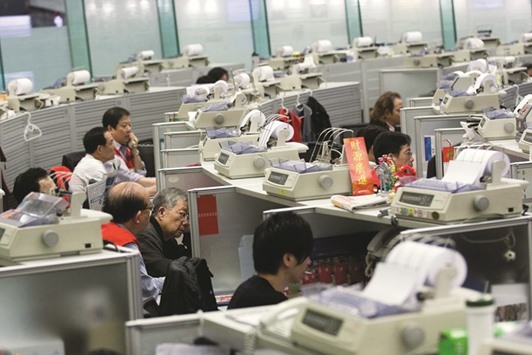Asian markets were up yesterday as oil prices rose and fresh stimulus from the Chinese central bank lifted hopes for the world’s number two economy.
Indian stocks soared more than 3% after the government on Monday unveiled an annual budget that promised billions of dollars to help struggling farmers and boost the rural economy.
But China was the key driver that powered markets across the region yesterday as investors reacted to the central bank decision to cut the proportion of funds that banks must set aside as reserves—Beijing’s latest attempt to tackle slowing growth in the powerhouse economy.
Policymakers cut the “reserve requirement ratio” (RRR) for financial institutions by 0.50 percentage points, freeing up more funds for them to lend.
The announcement boosted the mood on trading floors, with Hong Kong climbing 1.55% by the end of trade and Shanghai jumping 1.68%. Sydney finished 0.85% higher.
Tokyo’s benchmark Nikkei 225 index had lingered in negative territory for most of the session as traders fretted about slowing global growth.
In Tokyo, the Nikkei 225 up 0.37% at 16,085.51 points; Shanghai – composite rose 1.68% at 2,733.17 points and Hong Kong - Hang Seng up 1.55% at 19,407.46 points at the close yesterday.
But as worries about China receded to the background, the Japanese yen—seen as a safe haven in times of turmoil—eased against the dollar, which is a plus for Japanese shares. At the closing bell, Tokyo was up 0.37%.
China’s central bank move came after a G20 finance ministers’ weekend meeting in Shanghai, which stressed the use of all available policy tools to boost growth and settle wild volatility on global equity markets.
“The RRR (reserve requirement ratio) announcement offered something for everyone,” Sean Callow, a foreign-exchange strategist in Sydney at Westpac Banking Corp, told Bloomberg News.
“You could welcome the easing as supportive of growth and indicative of less pressure from capital outflows, or you could see it as a reflection of even greater weakness than expected,” Callow added.
However, weak Chinese manufacturing figures on Tuesday offered the latest grim sign of slowing growth in China’s economy.
February manufacturing activity shrank at its fastest rate in four years.
The official Purchasing Managers’ Index (PMI), which tracks activity in factories and workshops, fell to 49.0 last month, figures from the National Bureau of Statistics (NBS) showed.
That marked the seventh consecutive monthly contraction in the official index, which Bloomberg News said was the longest on record.
“Given the state that the Chinese economy is in, there’s probably more that they can do to cushion the economy on the downside,” said Wilfred Sit, Baring Asset Management’s chief investment officer in Hong Kong.
“They’re going to have to do more.”
The focus on China would now shift to the National People’s Congress, the annual meeting of its rubber-stamp parliament, beginning on Saturday, traders said.
Oil prices rose marginally after a rally in US trading stoked by major crude consumer China’s moves to tackle its slowing economy and top producer Saudi Arabia welcoming cooperative action to stabilise the market.
Riyadh suggested openness in reaching a coordinated solution to market volatility, as a global supply glut weighs on prices.
US benchmark crude for April gained eight cents to $33.83 a barrel yesterday while Brent was up one cent at $36.58 a barrel.
In currency markets, the dollar rose to ¥112.86 from ¥112.72 in New York late Monday.

Traders monitor transactions at the Hong Kong Stock Exchange. The Hang Seng closed up 1.55% to 19,407.46 points yesterday.


